It looks like you're using an Ad Blocker.
Please white-list or disable AboveTopSecret.com in your ad-blocking tool.
Thank you.
Some features of ATS will be disabled while you continue to use an ad-blocker.
share:
Hello!
i wanted to share with you all one of my greatest loves from the world of myth and story, and to my eyes and ears, one of the greatest of the world's mysterious and magical tales - The Kalevala
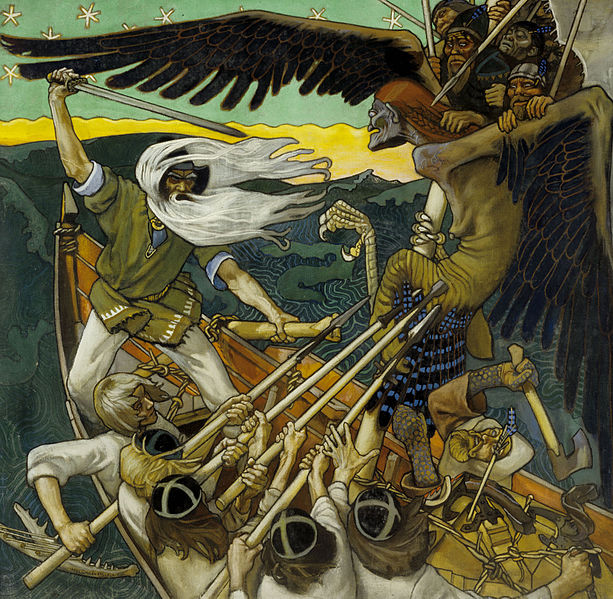
The Kalevala is an epic poem in Finnish, compiled and published in the nineteenth century by Elias Lonnrot from stories and songs that he collected while travelling and working in Karelia - stories and songs that had once been the staple of Finnish folklore but were starting to disappear.
Full of adventure, shamanic magic, jealousy, betrayal, gods, tragedy, and finally triumph... it's a great shame that this is relatively unknown outside of Finland where it is considered the national epic - for me it easily rivals the tales of Cuchullain, King Arthur, the Volsungs and any others. It was much loved by Tolkien and the influence of it can be seen in The Silmarillion, both in the Ainulindale and the story of Turin Turambar..... If just one new person picks up a copy because of this, then i will be a happy man!
i lost my copy three or four years ago, and have not replaced it yet to my shame, but this is the edition i would recommend due to the poetic translation (it's a hefty book, the term epic is not used lightly here)
www.amazon.co.uk...
older translations may suffer in being much heavier reads due to idiom etc, beware, but here is the sacred texts link..
www.sacred-texts.com...
The Story is enormous in scope and i could not hope to give a precy of it here, but i want to give some tasters for the curious
en.wikipedia.org...(synopses)
Beginning with the creation of the world as the Daughter of the Air grows to become the Water-Mother and we see the world bought into being from a duck's egg; The first man, Vainamoinen is finally born from her after struggling for an age to escape her womb..
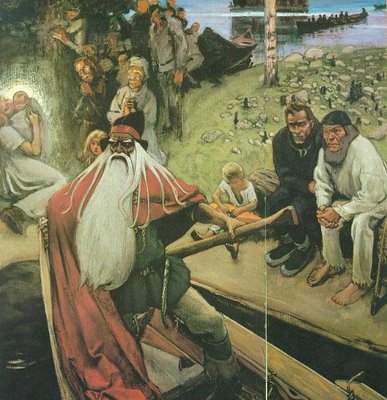
the already old and grey Vainamoinen is the main protagonist, a wily shaman whose voice is magic itself - some have argued that he is an ancient god of the Karelians, others that he was a real shaman in ancient times.
In the early parts of the story he helps to fill the world with plants, travels inside a great giant in the earth to gain wisdom, reveals the origins of iron in a magical episode to heal a terrible axe wound, and battles with an arrogant young shaman/singer... using his magical songs to transform every belonging of his rival, eventually bringing him close to death as he sings him back into the earth only to be saved by a bargain that ends in tragedy. The defeated shaman promises his siser Aino to the lonely Vainamoinen, only for her to reject him and drown herself
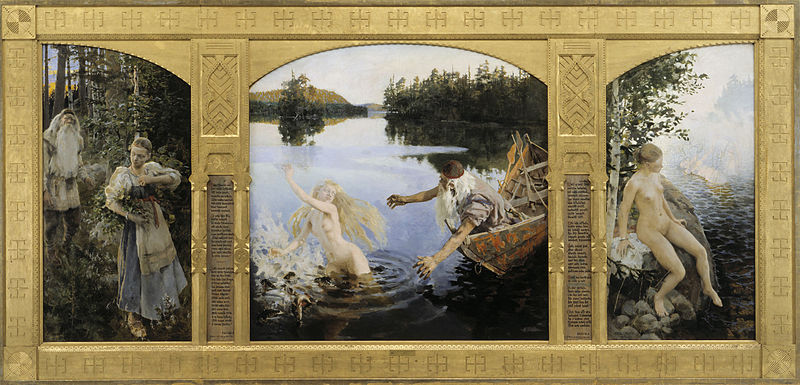
as he continues to look for a wife, he ends stranded in the mysterious Northland. The mistress who rules here agrees to return the wizard to his home for a price - she wants him to convince the great smith, Ilmarinen (another main figure in Finnish myth/paganism) to forge "The Sampo" - she will even offer the smith a bride in return.
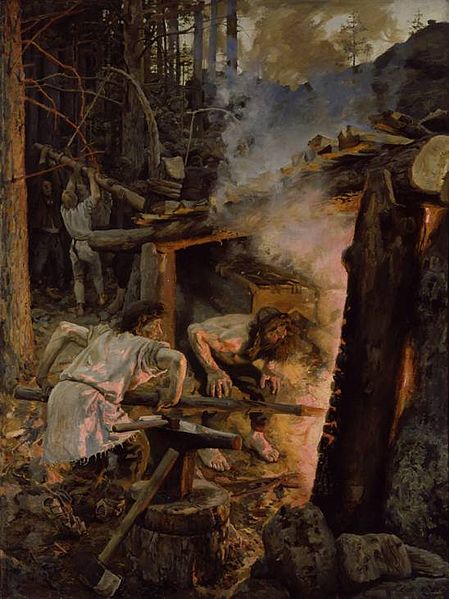
now the story weaves and wends it's way amongst a variety of characters and events, and is dark and mysterious in it's tone, dealing with magical elk and pike, curses, magical weapons, the land of the dead and many other features that will have lovers of myth and legend, as well as readers of fantasy drooling all over their laps as they read, but The Sampo with it magical powers is the real element of mystery in The Kalevala.
It is unclear exactly what this item is - though it is of great power and brings "horn of plenty" type powers to it's owner - it is often represented as a grain mill that can produce anything the owner desires
en.wikipedia.org...
so begins the rest of the story, Ilmarinen's promised marriage fails, the land suffers for the loss of the Sampo (while the Northland, possessing the Sampo flourishes) and Vainamoinen and Ilmarinen's mythic quest to recover the Sampo and bring it home begins.
JRR Tolkien was ofc an expert on northern european myth and the Kalevala was a favourite of his - one of the more prominent figures in the Kalevala is the tragic Kullervo
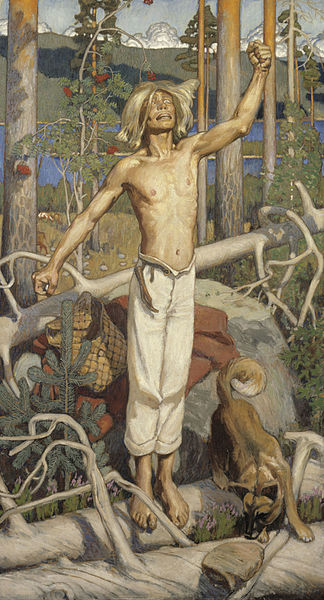
Kullervo is acknowledged as the template used for Turin Turambar and his story is an unsurprisingly grim one - his people are killed, he is taken into slavery and has magical powers and a terrible temper. In his journeys he seduces a girl who turns out to be his long lost sister and out of horror at what they have done she commits suicide. Kullervo obtains a magical sword and eventually gains the revenge that has obsessed him - his part in the story then ends when he offers the sentient magical sword his life, which it eagerly accepts (shades of Moorcock and Stormbringer here too).
I would love to know more about the Sampo and i know we have some Finnish members here - perhaps they could share their thoughts if they come across this thread. The Kalevala has found it's way into many elements of Finnish culture, not just some fabulous art which it has been my pleasure to include here, but the music of Sibelius as well as modern metal bands like Ensiferum amongst other things.
i could fill pages writing about how much i love this story, and of the rich adventure and high strangeness that readers will discover, but i do not wish to re-tell a story that already fills some seven hundred pages of verse when i could not do justice to it - go out and read it folks - it's one of the world's literary treasures and a window into the past, i hope some of you find a copy and enjoy it as much as i did.
i wanted to share with you all one of my greatest loves from the world of myth and story, and to my eyes and ears, one of the greatest of the world's mysterious and magical tales - The Kalevala

The Kalevala is an epic poem in Finnish, compiled and published in the nineteenth century by Elias Lonnrot from stories and songs that he collected while travelling and working in Karelia - stories and songs that had once been the staple of Finnish folklore but were starting to disappear.
Full of adventure, shamanic magic, jealousy, betrayal, gods, tragedy, and finally triumph... it's a great shame that this is relatively unknown outside of Finland where it is considered the national epic - for me it easily rivals the tales of Cuchullain, King Arthur, the Volsungs and any others. It was much loved by Tolkien and the influence of it can be seen in The Silmarillion, both in the Ainulindale and the story of Turin Turambar..... If just one new person picks up a copy because of this, then i will be a happy man!
i lost my copy three or four years ago, and have not replaced it yet to my shame, but this is the edition i would recommend due to the poetic translation (it's a hefty book, the term epic is not used lightly here)
www.amazon.co.uk...
older translations may suffer in being much heavier reads due to idiom etc, beware, but here is the sacred texts link..
www.sacred-texts.com...
The Story is enormous in scope and i could not hope to give a precy of it here, but i want to give some tasters for the curious
en.wikipedia.org...(synopses)
Beginning with the creation of the world as the Daughter of the Air grows to become the Water-Mother and we see the world bought into being from a duck's egg; The first man, Vainamoinen is finally born from her after struggling for an age to escape her womb..

the already old and grey Vainamoinen is the main protagonist, a wily shaman whose voice is magic itself - some have argued that he is an ancient god of the Karelians, others that he was a real shaman in ancient times.
In the early parts of the story he helps to fill the world with plants, travels inside a great giant in the earth to gain wisdom, reveals the origins of iron in a magical episode to heal a terrible axe wound, and battles with an arrogant young shaman/singer... using his magical songs to transform every belonging of his rival, eventually bringing him close to death as he sings him back into the earth only to be saved by a bargain that ends in tragedy. The defeated shaman promises his siser Aino to the lonely Vainamoinen, only for her to reject him and drown herself

as he continues to look for a wife, he ends stranded in the mysterious Northland. The mistress who rules here agrees to return the wizard to his home for a price - she wants him to convince the great smith, Ilmarinen (another main figure in Finnish myth/paganism) to forge "The Sampo" - she will even offer the smith a bride in return.

now the story weaves and wends it's way amongst a variety of characters and events, and is dark and mysterious in it's tone, dealing with magical elk and pike, curses, magical weapons, the land of the dead and many other features that will have lovers of myth and legend, as well as readers of fantasy drooling all over their laps as they read, but The Sampo with it magical powers is the real element of mystery in The Kalevala.
It is unclear exactly what this item is - though it is of great power and brings "horn of plenty" type powers to it's owner - it is often represented as a grain mill that can produce anything the owner desires
the Sampo is forged by Ilmarinen, a legendary smith, as a task set by the Mistress of Pohjola in return for her daughter's hand.
"Ilmarinen, worthy brother,
Thou the only skilful blacksmith,
Go and see her wondrous beauty,
See her gold and silver garments,
See her robed in finest raiment,
See her sitting on the rainbow,
Walking on the clouds of purple.
Forge for her the magic Sampo,
Forge the lid in many colors,
Thy reward shall be the virgin,
Thou shalt win this bride of beauty;
Go and bring the lovely maiden
To thy home in Kalevala."[2]
Ilmarinen works for several days at a mighty forge until finally the Sampo is created:
On one side the flour is grinding,
On another salt is making,
On a third is money forging,
And the lid is many-colored.
Well the Sampo grinds when finished,
To and fro the lid in rocking,
Grinds one measure at the day-break,
Grinds a measure fit for eating,
Grinds a second for the market,
Grinds a third one for the store-house..
en.wikipedia.org...
so begins the rest of the story, Ilmarinen's promised marriage fails, the land suffers for the loss of the Sampo (while the Northland, possessing the Sampo flourishes) and Vainamoinen and Ilmarinen's mythic quest to recover the Sampo and bring it home begins.
JRR Tolkien was ofc an expert on northern european myth and the Kalevala was a favourite of his - one of the more prominent figures in the Kalevala is the tragic Kullervo

Kullervo is acknowledged as the template used for Turin Turambar and his story is an unsurprisingly grim one - his people are killed, he is taken into slavery and has magical powers and a terrible temper. In his journeys he seduces a girl who turns out to be his long lost sister and out of horror at what they have done she commits suicide. Kullervo obtains a magical sword and eventually gains the revenge that has obsessed him - his part in the story then ends when he offers the sentient magical sword his life, which it eagerly accepts (shades of Moorcock and Stormbringer here too).
I would love to know more about the Sampo and i know we have some Finnish members here - perhaps they could share their thoughts if they come across this thread. The Kalevala has found it's way into many elements of Finnish culture, not just some fabulous art which it has been my pleasure to include here, but the music of Sibelius as well as modern metal bands like Ensiferum amongst other things.
i could fill pages writing about how much i love this story, and of the rich adventure and high strangeness that readers will discover, but i do not wish to re-tell a story that already fills some seven hundred pages of verse when i could not do justice to it - go out and read it folks - it's one of the world's literary treasures and a window into the past, i hope some of you find a copy and enjoy it as much as i did.
edit on 18-3-2013 by skalla because: clarity, the typos i managed to spot
reply to post by skalla
Very cool! Yes, Tolkien was a fan to put it mildly. He got many of his ideas from it..
Nat Geo: Beyond LOTR Movie
Very cool! Yes, Tolkien was a fan to put it mildly. He got many of his ideas from it..
Nat Geo: Beyond LOTR Movie
Tolkien's High Elvish language, Quenya, was inspired by Finnish. Tolkien taught himself Finnish in order to read the Kalevala, a 19th-century compilation of old Finnish songs and stories arranged by Elias Lönnrot into a linear epic poem and completed in 1835 and revised in the mid-1800s.
Originally posted by Frogs
reply to post by skalla
Very cool! Yes, Tolkien was a fan to put it mildly. He got many of his ideas from it..
Nat Geo: Beyond LOTR Movie
Tolkien's High Elvish language, Quenya, was inspired by Finnish. Tolkien taught himself Finnish in order to read the Kalevala, a 19th-century compilation of old Finnish songs and stories arranged by Elias Lönnrot into a linear epic poem and completed in 1835 and revised in the mid-1800s.
absolutely - if you read the Silmarillion and Books of Lost Tales/History of Middle Earth volumes etc, the influence of the Kalevala is much easier to see, such as Quenya and many of the earlier (in some cases later changed) character and place names. Kullervo's influence on Turin is the most clear example (both are wonderful stories, and Kullervo is such a great tragic anti-hero that i'm sure JRRT could barely resist)... though the Ainulindale with it's creation of the world via singing must have had a hefty waft of Vainamoinen's arts in there as well i think.
i've also seen folk suggest that there is a link between Gandalf and Vainamoinen, though i dont really see that as he lacks Gandalf's compassion and insight, even if they do share a love of beards and swords
Interesting to see "foreigner view" on kalevala. Makes me wonder how much of the story is lost simply because finnish language is in a league of it's
own. Most obvious way kalevala has influenced Finland is names naturally. My bank is Sampo and there are streets and places named after the epic.
Unfortunately my bank despite the name doesn't grind me infinite fortune
I'm going to have to rehash my basic knowledge of the tales now that I saw this topic.
[Edit to add] Found this really interesting. Always interesting to see similarities between different myths and cultures.
Source
I'm going to have to rehash my basic knowledge of the tales now that I saw this topic.
[Edit to add] Found this really interesting. Always interesting to see similarities between different myths and cultures.
Similar devices
The Cornucopia of Greek mythology also produces endless goods.
Some versions of the Grail myth emphasize how the Grail creates food and goods.
The Mill Grótti of the Grottasöngr in Nordic mythology also produces gold (as well as peace and happiness) and salt.
The Mahabharatha speaks about the Akshaya Pathram, a vessel/bowl capable of creating food. It stopped providing at the end of the day when the lady of the house had her last meal. This vessel was provided to the Pandavas, when in exile, by Krishna.
Source
edit on 18/3/2013 by PsykoOps because: (no reason given)
Beautiful Post and a Beautifull Story.
For the tolkien fans, there is a relatively new book out called the Narn I Hin Hurin, or the Tales of The Children Of Hurin that fleshes out the story from the Silmarillian in more detail. Christopher Tolkien has promissed a similar treatment for the Layof Leithian, regarding Beren and Luthien, and the Fall of Gondolin.
If I remember aright, the three main characters in the story are the basis for the three main tribes of the elves, the Vanyar, the Noldor, and the Teleri.
As for the Sampo, this has been mylifelong study. I believe it is the finnish version of the Ark of the Covenant, the Holy Grail, etc. If anyone is interested in learing more about this 'object' Ican provide a lot list of references.
Melyanna
(10 points to anyone who can decode my name.)
For the tolkien fans, there is a relatively new book out called the Narn I Hin Hurin, or the Tales of The Children Of Hurin that fleshes out the story from the Silmarillian in more detail. Christopher Tolkien has promissed a similar treatment for the Layof Leithian, regarding Beren and Luthien, and the Fall of Gondolin.
If I remember aright, the three main characters in the story are the basis for the three main tribes of the elves, the Vanyar, the Noldor, and the Teleri.
As for the Sampo, this has been mylifelong study. I believe it is the finnish version of the Ark of the Covenant, the Holy Grail, etc. If anyone is interested in learing more about this 'object' Ican provide a lot list of references.
Melyanna
(10 points to anyone who can decode my name.)
reply to post by Melyanna
Your name is a Finnish variant of the name MAGDALENE
Your name is a Finnish variant of the name MAGDALENE
link
MALIN
GENDER: Feminine
USAGE: Swedish, Norwegian, Finnish
Meaning & History Swedish and Norwegian : short form of MAGDALENE
reply to post by PsykoOps
reply to post by Melyanna
Thanks for commenting
i too see the Sampo as being very much like the Cornucopia, Ark of the Covenant etc, and most particularly the Holy Grail - as mentioned it can produce food and drink like the Grail in many stories, as well as being of debatable and mysterious form.
Mythologists and such have interpreted it in a variety of ways that are no doubt familiar to readers on such subjects: a religious artifact or heirloom, a magical model of the world tree, a mystical stone, a quern or grain mill and so on.. i found some articles on the subject, not all complete sadly - one alludes to it having the visual appearance of the Fly Agaric/Amanita Muscaria used as an entheogen in Scandinavian and Siberian Shamanism (amongst others):
alignment2012.com...
edj.net...
Related links would be most welcome!
Also i loved "The Children of Hurin" but was a bit disappointed to see that rather than the Tale of Tur/Tuor and The Fall of Gondolin etc - it's by far my favourite piece of Tolkien, and The Book of Lost Tales Vol 2 contains his best work IMO - i look forwards to seeing a complete volume of related stories etc. The Elven groups are established much earlier on btw, but the Numenoreans begin with Beren and Luthien, and Tuor and Idril are the parents of Earendil iirc (etc)
reply to post by Melyanna
Thanks for commenting
i too see the Sampo as being very much like the Cornucopia, Ark of the Covenant etc, and most particularly the Holy Grail - as mentioned it can produce food and drink like the Grail in many stories, as well as being of debatable and mysterious form.
Mythologists and such have interpreted it in a variety of ways that are no doubt familiar to readers on such subjects: a religious artifact or heirloom, a magical model of the world tree, a mystical stone, a quern or grain mill and so on.. i found some articles on the subject, not all complete sadly - one alludes to it having the visual appearance of the Fly Agaric/Amanita Muscaria used as an entheogen in Scandinavian and Siberian Shamanism (amongst others):
The visual resemblance to the Amanita muscaria mushroom is more than a coincidence. Among Siberian shamans, Amanita mushrooms with seven little white spots are especially prized, as they embody the seven stars of the Big Dipper. Thus, the inverted bowl shape of the mushroom reflects the dome-shaped sky, the kirjokansi of the Sampo. In the Sampo, we find a cosmological model common to all Asian, Indian, and Siberian shamanism as well as a picture of Soma-as-mushroom. The model is even found in the Nordic mythology, where Yggsdrasil is the cosmic tree. At the base of Yggsdrasil three goddesses, the Norns, can be found. They symbolize past, present, and future. These goddesses are deities of the magic tree, and offer travelers an elixir to refresh them on their journey. The Mordvin people of eastern Europe tell a story of a giant birch tree growing on a hill in the depths of the forest, the roots of which ring around the world. (The mycelial mat of mushrooms can stretch for miles, and Amanita prefers to grow in the roots of birch trees). The branches of this tree surround the heavens.
The Theft of the Sampo, on one level of interpretation, involves the removal of the polar axis to another location, thus implying precession or perhaps even a pole shift. The pertinent passage from the Kalevala reads:
We will take the Sampo yonder
And convey the ciphered cover
To that misty point of land
At the head of Foggy Island[5]
It is tempting to interpret the “head” of Foggy Island as the “top” of the Milky Way, and the polar Sampo’s relocation there as being the Finnish equivalent of a polar-to-galactic shift.
As can be seen, the connections between Soma and Sampo are strong and deep. Much more could be explored in this direction. The Finnish Theft of Sampo story is, like its Vedic counterpart, rich in symbolic associations on many levels: sexual connotations, cosmology, sacred plants, male-female dynamics, the spiritual quest—even intimations of precession—wrapped into a seamless whole. Ruminations aside, what will concern us the most is the Theft of the Sampo story retold from Louhi’s viewpoint. A little background first.
alignment2012.com...
One of the uniquely Finnish artifacts is the Sampo, although its symbology partakes of the universal concept of the Sacred Tree. It is a cosmological metaphor for the stellar dome centered upon the Polestar and, at the same time, a kind of Magic Mill capable of producing wealth. The Sampo is a model of the cosmos directly springing from the traditions of Siberian mythology, which has many features in common with Finnish myth: the cosmic axis, shamanic journeys to the Polestar (the Nail of the North), the Sacred Tree with three, seven, or nine levels, the shaman's tent with its central pole and the starry "ciphered cover." The Polestar was the universal cosmic axis of these circumpolar schemes, but the Sampo is uniquely Finnish. Surviving through the archaic surges of historical migrations, relayed from generation to generation by word of mouth alone, its details transforming in the slow-pass of ages, the Sampo's conceptual antecedents travelled across the Siberian tundra from Central Asia thousands of years ago. But in the Finnish legends, its true nature is shrouded. And yet myth has a way of preserving the essence of ancient knowledge.
edj.net...
Related links would be most welcome!
Also i loved "The Children of Hurin" but was a bit disappointed to see that rather than the Tale of Tur/Tuor and The Fall of Gondolin etc - it's by far my favourite piece of Tolkien, and The Book of Lost Tales Vol 2 contains his best work IMO - i look forwards to seeing a complete volume of related stories etc. The Elven groups are established much earlier on btw, but the Numenoreans begin with Beren and Luthien, and Tuor and Idril are the parents of Earendil iirc (etc)
Very nicely presented overview, thanks for sharing. The suggestions of an ancient food dispensing machine are intriguing.

I wonder why 'Ancient Astronaut Theorists' never suggest the Aliens gave anything useful...

I wonder why 'Ancient Astronaut Theorists' never suggest the Aliens gave anything useful...
Thanks a lot for this! I always welcome new reading material, and this is just the stuff I love to read! I'm going to pick up a copy, so start being
happy
Many thanks for the further replies, i'm really glad that this has been of interest to readers here!
If anyone is wondering what the material may sound like when presented in the manner it was intended, take a listen to this..
This one contains the battle between Vainamoinen and Joukahainen, the younger Shaman - it sounds utterly primal in the native Finnish and can transport you to a fireside long, long ago
Traditionally, it was accompanied by music from the Kantele, a native stringed instrument
en.wikipedia.org...

sorry, when i found that pic, i just had to post it. just a typical Finnish dude and his Kantele, i guess
There is also an old Finnish drama based on the story - it's actually very good! The other parts are linked from the first vid
and last but certainly not least, a fascinating film on some of the magical folk traditions of the area, containing superb old footage.
If anyone is wondering what the material may sound like when presented in the manner it was intended, take a listen to this..
This one contains the battle between Vainamoinen and Joukahainen, the younger Shaman - it sounds utterly primal in the native Finnish and can transport you to a fireside long, long ago
Traditionally, it was accompanied by music from the Kantele, a native stringed instrument
en.wikipedia.org...

sorry, when i found that pic, i just had to post it. just a typical Finnish dude and his Kantele, i guess
There is also an old Finnish drama based on the story - it's actually very good! The other parts are linked from the first vid
and last but certainly not least, a fascinating film on some of the magical folk traditions of the area, containing superb old footage.
edit on 19-3-2013 by skalla because: YT linky fixing
edit on 19-3-2013 by skalla because:
clarity
reply to post by skalla
Wow, what a complete and detailed thread. I knew none of this (except for the mushrooms) and the Tolkien connection to this older material shows that he knew a good thing when he stole it. I've never read Tolkien (tried, couldn't get past the first few pages of one of his books), and now I know why - he borrowed his material from a better and bolder source. Thanks for the thread.
For copies of this book and others, maybe some people here haven't heard of Abebooks. If you don't know of it, you're in for a treat. It's a site where the world's used and rare booksellers list their wares, and you can find almost everything on it (for me the older the better). Using the advanced option gives you more of a view. If nothing else, the listings on it often carry detailed descriptions of a book and its author, so they provide little history lessons in themselves. Long story long, maybe there are old copies of The Kalevala on there (I haven't looked).
Wow, what a complete and detailed thread. I knew none of this (except for the mushrooms) and the Tolkien connection to this older material shows that he knew a good thing when he stole it. I've never read Tolkien (tried, couldn't get past the first few pages of one of his books), and now I know why - he borrowed his material from a better and bolder source. Thanks for the thread.
For copies of this book and others, maybe some people here haven't heard of Abebooks. If you don't know of it, you're in for a treat. It's a site where the world's used and rare booksellers list their wares, and you can find almost everything on it (for me the older the better). Using the advanced option gives you more of a view. If nothing else, the listings on it often carry detailed descriptions of a book and its author, so they provide little history lessons in themselves. Long story long, maybe there are old copies of The Kalevala on there (I haven't looked).
reply to post by coredrill
I did not know that Melyanna was a form of Malin,so thanks for that. But I can only give you 5 points as there is an even more exact connection...
I
I did not know that Melyanna was a form of Malin,so thanks for that. But I can only give you 5 points as there is an even more exact connection...
I
Awesome, awesome thread, skalla,
I have been dying to make some inroads in to Finnish (Laplander) shamanism and magic; I was so happy to see this thread today.
The Sampo sounds similar to The Grail, in the sense that it is able to provide whatever sustenance that the bearer wishes for or desires. The detail about 'the land suffering' at the loss of the Sampo, reminds me of the Grail's attributes, as well.
You are right, skalla, just reading about it in your thread has got me drooling: "The Kalevala: it's what's for dinner", I can't wait to start in. I also really love the characterizations; did Vainamoinen age backwards like Merlin?
Thanks for a beautiful thread, skalla, I am really digging the images, too.
I have been dying to make some inroads in to Finnish (Laplander) shamanism and magic; I was so happy to see this thread today.
The Sampo sounds similar to The Grail, in the sense that it is able to provide whatever sustenance that the bearer wishes for or desires. The detail about 'the land suffering' at the loss of the Sampo, reminds me of the Grail's attributes, as well.
You are right, skalla, just reading about it in your thread has got me drooling: "The Kalevala: it's what's for dinner", I can't wait to start in. I also really love the characterizations; did Vainamoinen age backwards like Merlin?
Thanks for a beautiful thread, skalla, I am really digging the images, too.
edit on 19-3-2013 by Bybyots because:
What a great introduction -- and yes, a book that I've browsed many years ago. You selected some choice classic illustrations, too!
There are so many common threads/themes here that show up in other folktales.
There are so many common threads/themes here that show up in other folktales.
Thanks for the information. I'll have to get a good copy.
Makes one wonder how many great tales were lost by the catholic take over of Europe.
Makes one wonder how many great tales were lost by the catholic take over of Europe.
reply to post by Frogs
I should read this.
The Sampo....the little you told of it reminds me of mythology arising from the ice age, where Finland had plenty of food and did well, while the rest of Europe was frozen over.
Interesting. Very interesting
I should read this.
The Sampo....the little you told of it reminds me of mythology arising from the ice age, where Finland had plenty of food and did well, while the rest of Europe was frozen over.
Interesting. Very interesting
Originally posted by poet1b
Thanks for the information. I'll have to get a good copy.
Makes one wonder how many great tales were lost by the catholic take over of Europe.
Only the ones that couldn't be altered into the biblical tale. Catholicism has a way of taking the current culture and grafting itself into it.
It is how we ended up with all those saints.
reply to post by Aleister
Thanks, but dont dis the Tolk tho! I wont go into detail but but he made a myth for Britain or maybe more particularly the English, that was quite authentic in the sources it used re the cultures and legends that feed into the land. The scope of his work is much greater than most realise, unless they have taken their reading to The Silmarillion and beyond... i'll look into the booksellers link too, many thanks!
reply to post by Byrd
It was actually the Art that inspired me to make the thread on a whim last night, just browsing for more pics/artists i had not seen - i may add some more later tonight and some references/links, glad you enjoyed it!
reply to post by Bybyots
Very glad you enjoyed it - i would have msg'd you about it if i had not seen you about - you are so right about the wasteland angle too - i had a hard time deciding what i had room to fit into the OP and in the reduction process that must have got lost. The Sampo could easily be it's fore-runner - it has the right attributes and i have no doubt that it is more than old enough... just sprinkle some christianity over the top and add a little gloss and bingo....
As for Vainamoinen and Merlin, there certainly are similarities, though i must say i dont remember Merlin aging backwards - Vainamoinen is born old after hundreds of years trying to free himself from Water-Mother's womb and is only freed after appealing to the other gods. Just like Merlin, his weakness would appear to be loneliness, or more specifically, the laydeez.
There are some great examples of sympathetic magic in there too, allusions to bear cults and more. It's somewhat crammed with the old ways.
reply to post by poet1b
reply to post by bigfatfurrytexan
obviously, the story being compiled when it was (nineteenth century), christianity does get a nod at the end, like so many other old tales written down closer to modern times... though it's little more than a post script/epilogue and does not play a role in the story whatsoever. Still annoying/unneccessary, but then we would not know about it at all otherwise and Lonnrot possibly was a devout christian, or alternatively needed to add a gloss to encourage publication of a very pagan tale. I'm not sure if 19c Finland would have been catholic, lutheran or orthodox etc though.
Thanks, but dont dis the Tolk tho! I wont go into detail but but he made a myth for Britain or maybe more particularly the English, that was quite authentic in the sources it used re the cultures and legends that feed into the land. The scope of his work is much greater than most realise, unless they have taken their reading to The Silmarillion and beyond... i'll look into the booksellers link too, many thanks!
reply to post by Byrd
It was actually the Art that inspired me to make the thread on a whim last night, just browsing for more pics/artists i had not seen - i may add some more later tonight and some references/links, glad you enjoyed it!
reply to post by Bybyots
Very glad you enjoyed it - i would have msg'd you about it if i had not seen you about - you are so right about the wasteland angle too - i had a hard time deciding what i had room to fit into the OP and in the reduction process that must have got lost. The Sampo could easily be it's fore-runner - it has the right attributes and i have no doubt that it is more than old enough... just sprinkle some christianity over the top and add a little gloss and bingo....
As for Vainamoinen and Merlin, there certainly are similarities, though i must say i dont remember Merlin aging backwards - Vainamoinen is born old after hundreds of years trying to free himself from Water-Mother's womb and is only freed after appealing to the other gods. Just like Merlin, his weakness would appear to be loneliness, or more specifically, the laydeez.
There are some great examples of sympathetic magic in there too, allusions to bear cults and more. It's somewhat crammed with the old ways.
reply to post by poet1b
reply to post by bigfatfurrytexan
obviously, the story being compiled when it was (nineteenth century), christianity does get a nod at the end, like so many other old tales written down closer to modern times... though it's little more than a post script/epilogue and does not play a role in the story whatsoever. Still annoying/unneccessary, but then we would not know about it at all otherwise and Lonnrot possibly was a devout christian, or alternatively needed to add a gloss to encourage publication of a very pagan tale. I'm not sure if 19c Finland would have been catholic, lutheran or orthodox etc though.
reply to post by skalla
There is nothing I love better than a bear cult.
There is a "Bear Charm" from the Greek magical papyri that I really wanted to link you to, but I could only find it here, if you scroll all the way to the bottom you can read it. This part has always cracked me up a little, because it makes me wonder at smearing one's self in what is essentially a fragrant marinade and then walking up to the bear to make one's request. The commentary to this papyri suggests that the 'bear' is the constellation Ursa major, but I always imagine the aspirant doing it in front of a bear cave...
There was also a bitchin bear cult in the movie 13th Warrior.
bear cults
There is nothing I love better than a bear cult.
There is a "Bear Charm" from the Greek magical papyri that I really wanted to link you to, but I could only find it here, if you scroll all the way to the bottom you can read it. This part has always cracked me up a little, because it makes me wonder at smearing one's self in what is essentially a fragrant marinade and then walking up to the bear to make one's request. The commentary to this papyri suggests that the 'bear' is the constellation Ursa major, but I always imagine the aspirant doing it in front of a bear cave...
xvii. Powerful Spell of the Bear which Accomplishes Anything
Take the Fat of a Black Ass, the Fat of a Dappled She-Goat, the Fat of a Black Bull, and Ethiopian Cumin, mix all together and make an Offering to the Bear, having as a Phylactery Hairs from the same Animals which you have plaited into a Cord and are wearing as a Diadem around your Head. Anoint your Lips with the Fats, smear your whole Body with Storax Oil, and make your Petition while holding a Single-Shooted Egyptian Onion. Speak concerning whatever you wish. Gird yourself with a Palm Fiber of a Male Date Palm, kneel down, and speak the following Formula:
There was also a bitchin bear cult in the movie 13th Warrior.
new topics
-
It's Offical Now
US Political Madness: 1 hours ago -
The reason it works is.....
General Chit Chat: 2 hours ago -
Dick Van Dyke saved from Wildfire by neighbours on his 99th birthday
People: 5 hours ago
top topics
-
It's Offical Now
US Political Madness: 1 hours ago, 7 flags -
Dick Van Dyke saved from Wildfire by neighbours on his 99th birthday
People: 5 hours ago, 3 flags -
The reason it works is.....
General Chit Chat: 2 hours ago, 3 flags
active topics
-
Christmas Dinner ??
Food and Cooking • 17 • : putnam6 -
It's Offical Now
US Political Madness • 6 • : Oldcarpy2 -
London Christmas Market BANS Word ‘Christmas’
Social Issues and Civil Unrest • 43 • : Freeborn -
The reason it works is.....
General Chit Chat • 1 • : Naftalin -
1 Billion dollars
General Entertainment • 12 • : Blueracer -
Trump says ownership of Greenland 'is an absolute necessity'
Other Current Events • 49 • : Xtrozero -
Can someone 'splain me like I'm 5. Blockchain?
Science & Technology • 97 • : Xtrozero -
NYPD arrests migrant who allegedly set woman on fire on subway train, watched her burn to death
Breaking Alternative News • 53 • : GENERAL EYES -
-@TH3WH17ERABB17- -Q- ---TIME TO SHOW THE WORLD--- -Part- --44--
Dissecting Disinformation • 3809 • : Crazierfox -
Dick Van Dyke saved from Wildfire by neighbours on his 99th birthday
People • 0 • : gortex
